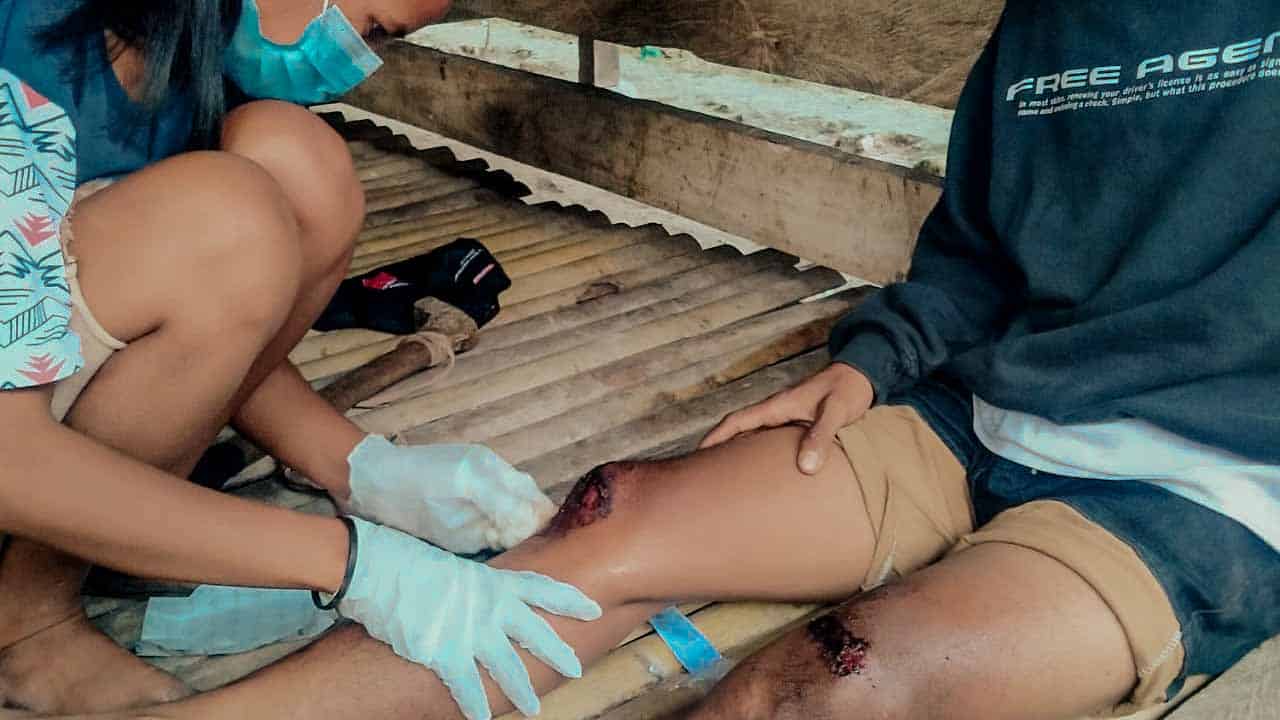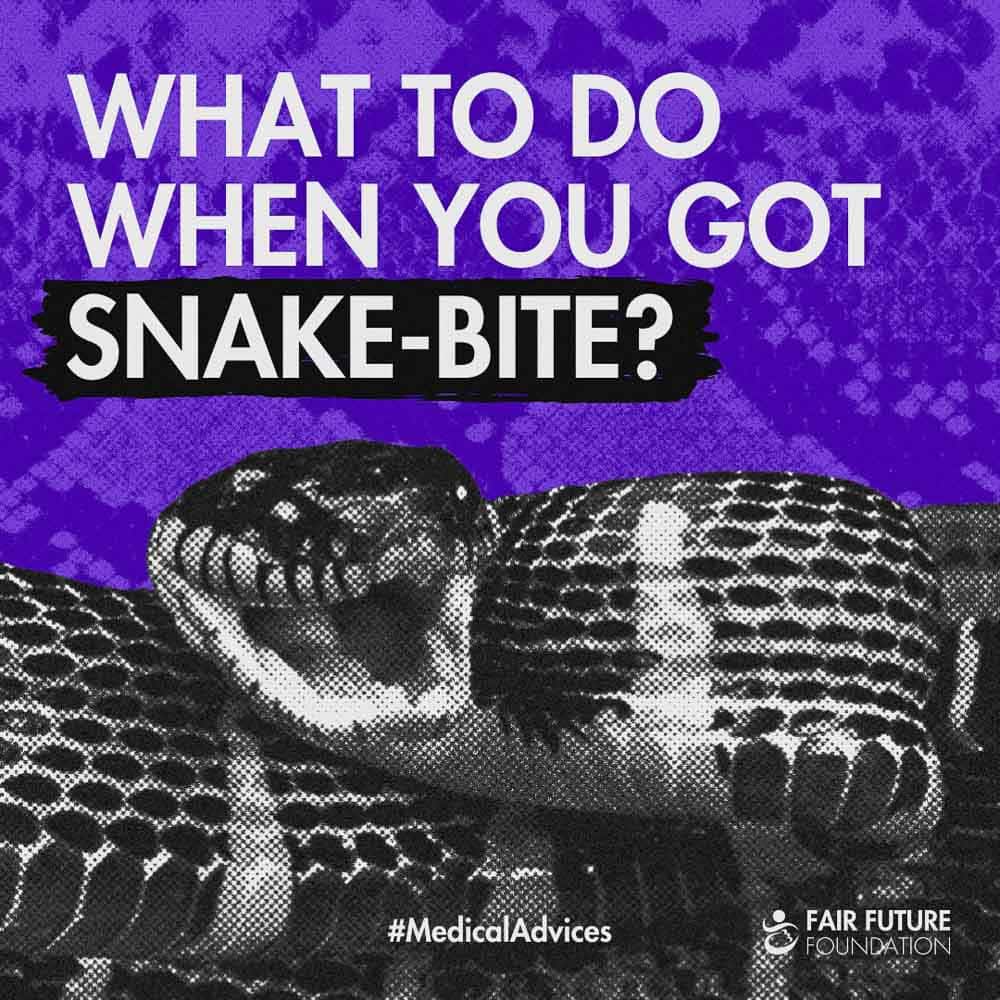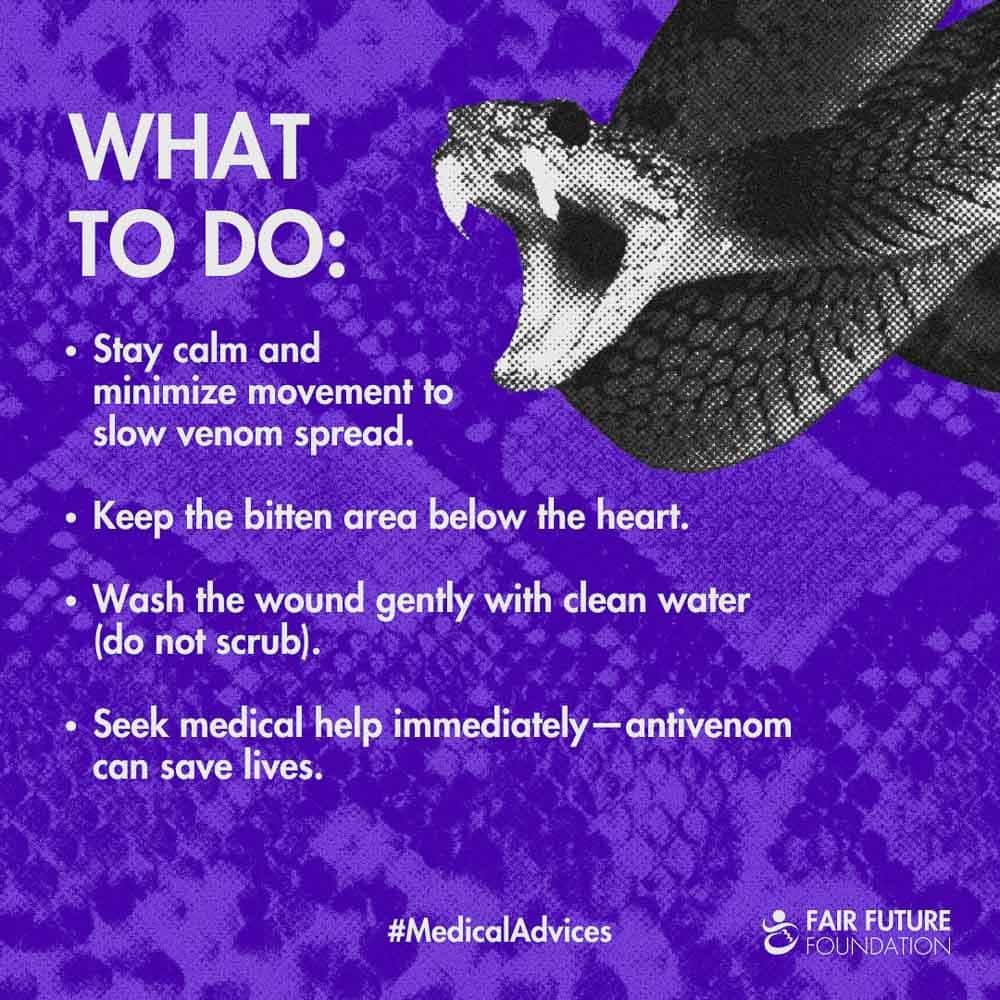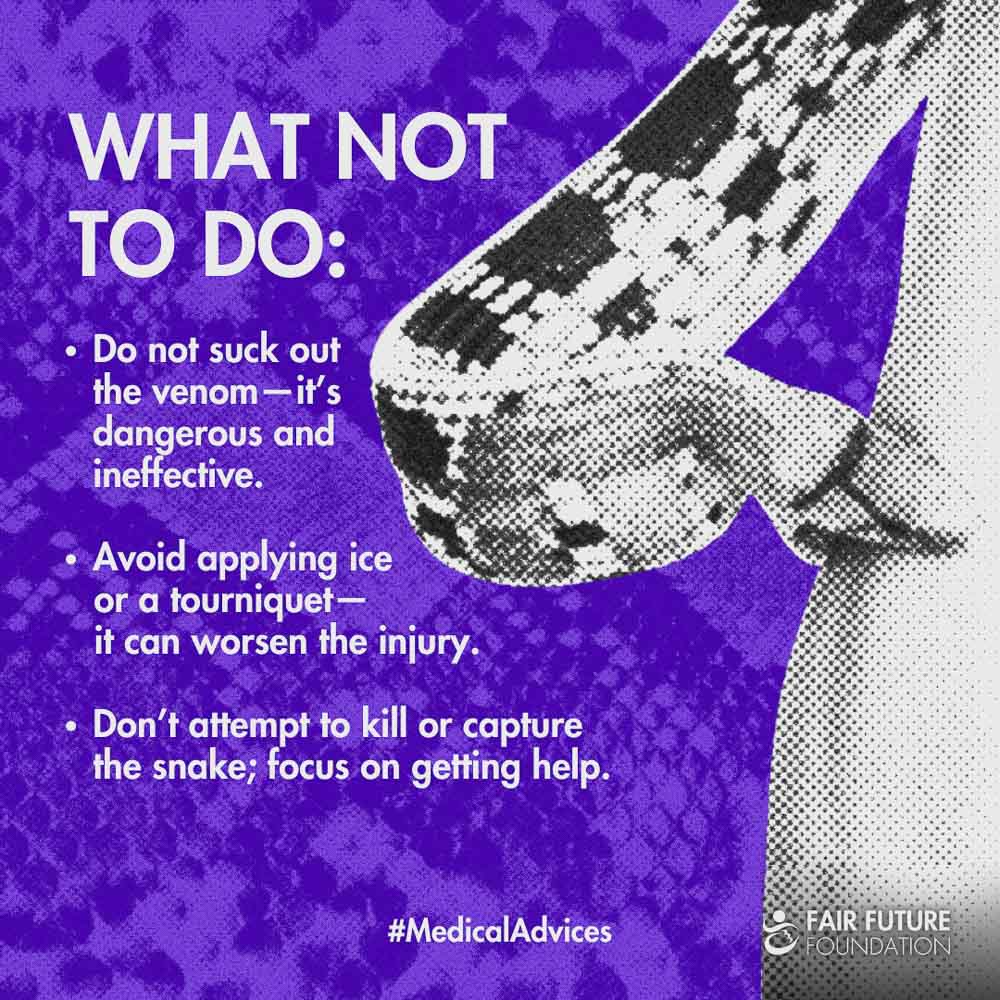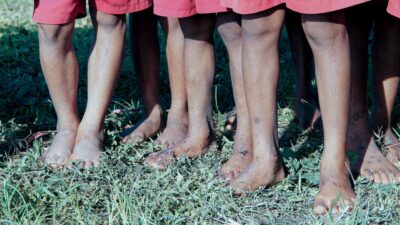
Learn essential steps to manage snake bites, from first aid tips to preventing complications in remote areas like East Sumba.
Recognizing, Treating and Preventing Snake Bites: Essential Tips for Remote Communities in Rural Areas.
Essential Steps to Prevent Deaths from Snake Bites: First Aid Guidelines, Common Mistakes to Avoid and Recognizing Venomous Snakes in NTT
#MedicalTips: How to Handle Snake Bites in East Sumba | In ultra-rural areas like the ones we have been operating in for so many years, limited access to healthcare and medical facilities poses significant challenges in managing emergencies such as snakebites.
These incidents are common, especially in highly rural areas with inadequate medical resources and information. As a result, many victims suffer serious health consequences or even face fatal outcomes due to delays in receiving necessary care.
Fair Future Foundation often encounters this problem through the efforts of Kawan Sehat health workers and the Primary Medical Care Program. This article aims to offer practical advice on managing snakebites, equipping communities with essential knowledge for timely and effective action that could potentially save lives.
Read more here
Identifying the Symptoms of a Snake Bite
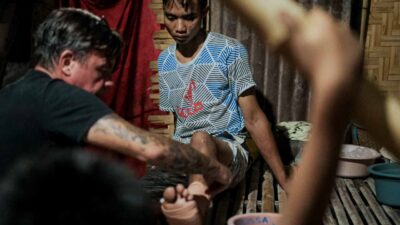
Learn essential steps to manage snake bites, from first aid tips to preventing complications in remote areas like East Sumba.
Getting Started
Snake bites pose a significant medical challenge in East Sumba, where remoteness and limited healthcare access heighten their risk. Although not every snake bite is venomous, many in this area involve species with venom that can cause serious complications or even be fatal if not treated quickly. Prompt recognition of symptoms is crucial for effective first aid and can greatly enhance outcomes, especially when medical help is not immediately available… Let me explain this to you:
In rural areas, it’s common for people to misinterpret snake bite symptoms or dismiss them as minor injuries. Education and awareness are crucial in overcoming this issue, ensuring that victims receive prompt medical attention. This section explains how to recognize the symptoms and emphasizes the importance of immediate action.
Symptoms List
- Puncture Wounds or Bite Marks: Snake bites typically result in two distinct puncture marks at the site where the fangs pierced the skin. These marks might be accompanied by small bruises or redness. However, the marks may resemble shallow scratches in certain instances, particularly with non-venomous bites. Noticing these marks is often the initial step in identifying a bite.
- Severe and Acute Pain or Burning Sensation: Bites from venomous snakes usually result in immediate, intense pain or a burning sensation at the bite location. The pain level can differ based on the snake species and the quantity of venom delivered. In some cases, the pain may start off mild but can escalate significantly within 30 to 60 minutes.
- Inflammation and Discoloration: The area surrounding the bite typically swells rapidly, turning visibly red, blue, or even purple. This discoloration signifies tissue damage from venom and is commonly associated with species such as pit vipers or vipers. In severe cases, the swelling can spread beyond the bite site, impacting the entire limb.
- Nausea, vomiting, or dizziness: Systemic symptoms such as nausea and dizziness may arise as the venom circulates through the bloodstream. These symptoms indicate that the venom impacts the central nervous system or causing a bodily reaction.
- Difficulty Breathing, Blurred Vision, or Weak Muscles: Severe envenomations, particularly from species such as cobras or kraits, can cause respiratory distress, blurred vision, or overall muscle weakness. These symptoms are crucial warning signs that necessitate immediate medical attention, as they may signal paralysis or harm to vital organs.
- Excessive Perspiration or Increased Salivation: Certain snake venoms, especially neurotoxic types, can overstimulate the nervous system, resulting in excessive sweating or salivation. These symptoms are frequently overlooked but can serve as crucial indicators of envenomation.
- …
Alex’s conclusions
Recognizing the symptoms of a snake bite quickly and accurately is crucial for administering appropriate first aid and obtaining immediate medical attention. The severity of a bite can vary depending on the species of snake and the location of the bite, but it is safest to treat every snake bite as if it is venomous until proven otherwise. This level of caution can save lives, particularly in remote areas like East Sumba, where access to antivenom and healthcare facilities may be limited, lacking, or delayed.
Steps to Take if You Experience a Snake Bite
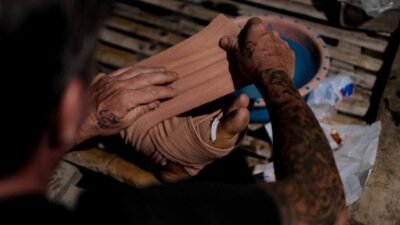
Learn essential steps to manage snake bites, from first aid tips to preventing complications in remote areas like East Sumba.
Getting Started
A snake bite is a REAL medical emergency that requires calm and careful actions. The main goal is to slow the spread of the venom, manage the victim’s symptoms, and ensure they get professional medical care quickly. Without proper treatment, venom can lead to organ damage, blood clotting issues, or even paralysis, depending on the snake species.
In remote areas in NTT such as East Sumba, where transportation, Puskesmas, or other medical facilities are frequently limited or very difficult to access, taking the correct steps immediately after a bite can be crucial, potentially saving lives. This section offers a straightforward guide to effective first-aid measures to reduce harm… Let me explain this to you:
Steps to Follow – Important
- Stay Calm and Reassure the Victim: Maintaining composure is essential for both the victim and those providing assistance. Anxiety and panic can raise heart rates, potentially speeding up how venom circulates in the bloodstream. Use a calming voice, urge the victim to breathe slowly and deeply, and prevent sudden movements. Supporting their tranquility can significantly enhance the effectiveness of subsequent first aid efforts.
- Limit movement and keep the bite area below heart level: Venom spreads more quickly through the body when the affected area is elevated or in motion. To help manage this, have the victim lie down or sit comfortably and ensure that the bitten limb remains below heart level. This position helps decrease blood flow to the site, slowing venom circulation and allowing for additional time to seek medical assistance.
- Remove Accessories: Remove rings, bracelets, watches, and tight clothing near the bite site immediately. Swelling from the venom can cause these items to constrict the area, potentially leading to additional pain or complications such as restricted blood flow.
- Immobilize the Affected Limb: To immobilize the bitten limb, apply a splint or use cloth or any other rigid support similar to how you would treat a fracture. Minimizing movement of the affected area can help prevent venom from spreading and worsening tissue damage. Make sure the splint is secure but not too tight, as this could restrict blood flow.
- Gently Clean the Wound: Gently rinse the bite area with clean, fresh water to eliminate any dirt or debris. Avoid scrubbing, as it may irritate the wound or push venom further into the tissue. Refrain from using chemicals such as alcohol or antiseptics since they can potentially worsen tissue damage caused by the venom.
- Get Medical Help Right Away: Act quickly when treating snake bites. Transport the victim to the nearest medical facility or Puskesmas without delay. Antivenom can neutralize venom effects, prevent serious complications, and save lives if available. If you can do so safely, provide any details about the snake’s appearance to medical personnel.
Alex’s conclusions
These measures aim to stabilize the victim, limit the circulation of venom, and prepare them for medical treatment. Although primary medical care ( first aid) plays a crucial role, it cannot replace professional medical care. Rapid response and awareness can save lives in the event of a snakebite. Educating communities about these practices improves the chances of survival, especially in highly rural areas where access to health care is limited.
What to Avoid After a Snake Bite
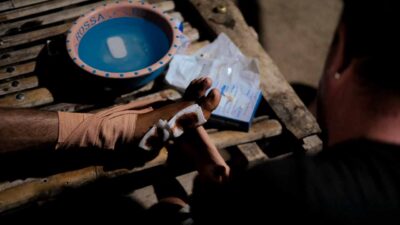
Learn essential steps to manage snake bites, from first aid tips to preventing complications in remote areas like East Sumba.
Getting Started
When confronted with a snake bite, many individuals turn to traditional remedies or outdated techniques that may be more harmful than beneficial. Methods like sucking out the venom or using tourniquets not only prove ineffective but can also exacerbate the victim’s condition… Let me explain this to you:
In rural areas, traditional beliefs frequently influence first-aid practices, making it crucial to dispel these myths. Knowing what actions to avoid after a snake bite can help prevent complications and ensure that attention is directed towards effective, evidence-based measures. This section emphasizes common mistakes to avoid and explains why they can be hazardous… Let me explain this to you:
Refrain from These Actions
- Avoid Sucking Out the Venom: Although movies and traditional practices often depict venom being sucked out, this method is both ineffective and dangerous. Using your mouth to extract venom can introduce bacteria into the wound, heightening the risk of infection. Furthermore, there’s a possibility that the person attempting it could expose themselves to the venom through cuts or sores in their own mouth. This outdated approach also wastes precious time that should be used for administering proper first aid and obtaining medical assistance;
- Avoid Using Ice or Cold Packs: Using ice or cold packs may aggravate tissue damage inflicted by venom. Certain venoms already hinder blood flow to the affected area, and applying cold can intensify this effect, potentially causing frostbite-like injuries or necrosis. It’s better to concentrate on keeping the wound clean and ensuring the victim’s stability instead of trying to numb pain with ice;
- Refrain from using tight bandages or tourniquets: Using tight bandages or tourniquets to restrict blood flow can lead to severe complications such as tissue death and nerve damage. Although the intention might be to slow down venom spread, completely cutting off circulation could result in limb amputation. To avoid this risk, opt for loose immobilization that limits movement without restricting blood flow;
- Avoid trying to kill or capture the snake: Attempting to kill or capture the snake can increase the risk of being bitten for both the victim and bystanders. Rather than focusing on dealing with the snake, prioritize moving the victim to a safe location and ensuring they receive medical attention. If it is possible to safely observe the snake’s appearance, take note of its size, color, and markings so this information can be shared with healthcare providers. Steer clear of any unnecessary encounters with the snake;
Alex’s conclusions
Understanding what to avoid following a snake bite is as crucial as knowing the right first aid steps. Steering clear of these common errors can prevent additional harm, keep the victim’s condition from worsening, and increase the likelihood of complete recovery. In communities with limited healthcare access, educating people on these aspects is vital for empowering them to respond effectively in emergencies. By debunking myths and emphasizing proven strategies, we can save lives and lessen the severe impact of snake bites.
Actions for Witnesses, Friends, and Family
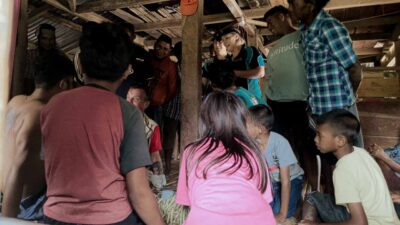
Learn essential steps to manage snake bites, from first aid tips to preventing complications in remote areas like East Sumba.
Getting Started
The actions of those present during a snake bite incident are equally important as the victim’s response. Witnesses, community members, friends, or family members are crucial in keeping the victim calm, immobilized, and quickly transported to medical care.
In the tight-knit communities of East Sumba, where families frequently work and live together, equipping everyone with the knowledge to handle emergencies can be life-saving. This section offers practical advice for those aiding a snake bite victim, ensuring their participation is both safe and effective.
Assistance Measures
- Keep the victim relaxed and confident: Witnesses are essential in assisting the victim to stay calm. Anxiety and panic can elevate heart rate, facilitating faster distribution of venom throughout the body. Use a soothing voice when speaking with the victim, urging them to breathe slowly and deeply while offering verbal reassurance to ease their anxiety. Steer clear of making alarming comments that might heighten their stress levels;
- Assist in Stabilizing the Injured Limb or Area: To slow the circulation of venom, help the victim immobilize the bitten limb. Use materials like sticks, cloth, or splints to stabilize it. Position the limb below heart level without overly restricting movement to avoid added discomfort. The goal is to limit unnecessary movement rather than cutting off circulation completely:
- Coordinate transportation to the closest Puskesma medical center: Timely medical attention is crucial following a snake bite. If emergency services are not accessible, arrange transport to the closest local healthcare center. For lengthy journeys, keep monitoring the victim’s condition and ensure they stay stable and hydrated during transit;
- Safely Observe the Snake’s Appearance: If it’s safe to do so, note the snake’s size, color, and markings to provide valuable information for medical personnel. This can assist in identifying the type of venom and determining suitable treatment. However, avoid trying to capture or handle the snake as it increases risk;
- Make sure the victim remains hydrated: If the victim is conscious and can swallow, provide them with small sips of water to help prevent dehydration, particularly if they are sweating a lot or feeling nauseous. Refrain from giving alcohol, caffeine, or any stimulants since these may exacerbate the effects of venom.
Alex’s conclusions
The local community, villagers, witnesses, friends, and family are of immense importance in the event of a snakebite. Their ability to provide calm and organised assistance greatly influences the victim’s chances of recovery. Simple actions such as immobilising the affected limb, arranging for possible transport, and reassuring people can save lives.
In remote areas such as Nusa Tenggara Timur, where access to medical care is difficult, passing on this knowledge to communities allows them to manage emergencies and save lives effectively.
Poisonous Serpents in East Sumba
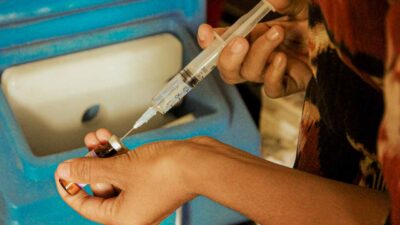
Learn essential steps to manage snake bites, from first aid tips to preventing complications in remote areas like East Sumba.
Getting Started
Nusa Tenggara Timur, East Sumba, is home to a wide variety of venomous snakes, many of which have adapted to the region’s unique climate and landscape. While encounters with these snakes are usually accidental, the consequences of a bite can be severe, ranging from localized pain to systemic problems such as blood clotting disorders or respiratory paralysis.
Becoming familiar with the venomous snakes present in the region can help communities implement preventative strategies, identify potential threats, and respond appropriately in the event of a snakebite. This section provides an overview of the most common venomous species in East Sumba, their behaviors, and the dangers their bites pose.
In addition, the development of antivenoms specifically designed for these species is essential for medical care in the region. While antivenoms can be lifesaving, they are often rare or completely unavailable in rural areas. Organizations such as Fair Future and Kawan Baik can focus on promoting better access to these treatments and educating people about their use… Let me explain this to you ok?
Venomous Snakes Commonly Found in East Sumba
- King Cobra (Ophiophagus Hannah): Known for its large size and potent neurotoxic venom. Learn more on Wikipedia
- Russell’s Viper (Daboia Russelii): Responsible for many bites in rural areas, causing severe bleeding disorders. Learn more on Wikipedia
- Krait (Bungarus spp.): Active at night, its venom leads to paralysis. Learn more on Wikipedia
- Pit Vipers (Trimeresurus spp.): Often found in forested areas; their venom causes localized pain and swelling. Learn more on Wikipedia
Final Thoughts
Being familiar with the types of snakes in your area can enhance preparedness and facilitate faster identification, helping medical responders deliver accurate treatment.
A final word of thanks to all of you…
Snakebites are a major health problem in areas such as East Sumba, but also elsewhere in this vast region of Nusa Tenggara Timur and Indonesia.
However, through awareness, preparedness and community education, their impact can be significantly reduced. Kawan Baik Indonesia, Fair Future Foundation and Kawan Sehat health workers working under the Primary Medical Care program are actively strengthening rural communities with the knowledge and tools to effectively respond to emergencies, saving lives and building resilience.
By adhering to these guidelines and disseminating them widely, we can collectively work towards a safer and healthier future.
Today, December 4th, 2024 – Alex Wettstein, Fair Future Foundation
Medical Advice: A Guide to Daily Wellness and Vitality
The Medical Advice section of the Fair Future Foundation offers practical guidance for everyday health issues. Our advice covers a range from illness prevention and injury management to mental wellness and family health strategies, empowering both individuals and communities alike. These insights are designed to foster healthier lifestyles by providing straightforward, actionable solutions that enhance overall well-being. Follow us on Instagram @fairfuturefoundation for additional updates.


